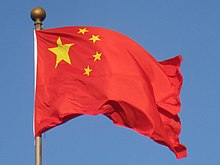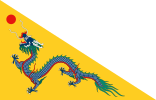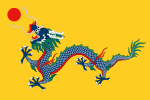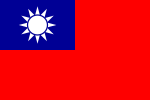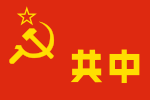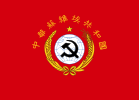Flag of the People's Republic of China
| Flag of the People's Republic of China | |
|---|---|
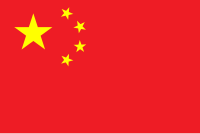 |
|
| Vexillological symbol : |
|
| Aspect ratio: | 2: 3 |
| Officially accepted: | October 1, 1949 |
The flag of the People's Republic of China was first hoisted on October 1, 1949. The official name of the Chinese national flag is Rote Fahne ( Chinese 红旗 , Pinyin hóngqí , in full: 五星 红旗 , wǔxīng hóngqí - "five-star red flag"). It is also used as the name for the main ideological newspaper and for the largest Chinese automobile.
Description and meaning
The basic color is communist red, which is also the color of the Han Chinese . It is also considered a lucky color in China. In the upper left corner is a large five-pointed yellow star, which is framed in an arc by four smaller stars.
The big star symbolizes the leadership of the communist party , the smaller stars stand for the four classes:
- Workers ,
- Farmers ,
- Petty bourgeois ,
- the national bourgeoisie . Entrepreneurs who had sided with the communists since the war against Japan in the 1930s and 1940s.
In a speech from 1949 , Mao Zedong identified these four terms as the four groups that make up the Chinese people.
The number five also has a traditional meaning. Traditionally one speaks of five rulers , five colors, five elements , five virtues , five sorts and historically of five parts of China: the actual China , Manchuria , Mongolia , Xinjiang and Tibet .
history
Dragons have been an important symbol of good luck in China for thousands of years. The dragon was the imperial symbol of the Zhou Dynasty from 1046-221 BC and also served as the emblem of the Qing Dynasty , the last dynasty of the Chinese Empire , at the end of the 19th century . Even if dragons no longer appear on the flag of the People's Republic of China, they are still very important culturally today and are both in China itself and internationally as a symbol of the Chinese nation. After the fall of the Qing Dynasty, the Republic of China was proclaimed in 1912 . The flag of the Republic of China visualized the principle of the nation consisting of five ethnic groups. Five stripes of different colors stood for the Han, the Manchu, the Mongols, the Muslims or Hui and the Tibetans. Yuan Shikai, who proclaimed himself emperor in 1915 , put a dominant red slanted cross in the flag over the other four colors. This should symbolize the rule of the Han over the other peoples of China . However, when the Chinese provinces rebelled against him, his empire quickly dissolved. The Republic of China, newly formed in 1928, chose a flag with a blue sky, white sun and red earth. This flag is still used in Taiwan today. The 12 rays of the sun represent the 12 hours of the clock by which all progress is measured. The flag of the Republic of China was also the party flag of the Kuomintang Chinese National Party, which was in power from 1928 to 1949.
Flag of the Qing Dynasty 1862–1890
Flag of the Empire of China (1915-1916)
Variant with a Greek cross
Flag of the Jiangxi Soviet 1931–1934
Flag of the Chinese Soviet Republic 1935–1937
When the Communist Party of China came to power and the People's Republic of China was established, a new flag was also introduced. In July 1949, the Preparatory Committee of the Political Consultative Conference of the Chinese People in China and the overseas Chinese solicited suggestions through a newspaper for the design of the national flag. It should be based on the geography, nationality, history and culture of China and communist ideals. It should be rectangular, with an aspect ratio of 2: 3, and mostly bright red. Of the 3,000 different designs, the decision was made for that by Zeng Liansong曾 聯 松, who worked for the modern economy agency . Liansong's flag originally featured a hammer and sickle in the upper corner, next to it an arched frame made of four stars. Since it looked too similar to the flag of the USSR, a large five-pointed star was used instead as a symbol of the Communist Party. The four stars to the right of it symbolize the four classes of the Chinese people named by Mao Zedong: workers, peasants, petty bourgeoisie and bourgeoisie. This form of the national flag has remained unchanged since the founding of the People's Republic of China. Mao Zedong and other party members initially preferred the yellow river flag with the party leader in the upper corner and a golden bar as a symbol of the yellow river, the cradle of Chinese culture. In the end, it came to the conclusion that the golden stripe could be interpreted as a symbol of a division between nation and revolution, so that Zeng Liansong's design became the national flag of the People's Republic of China.
At the 2016 Summer Olympics in Rio de Janeiro , a false flag was initially used for the People's Republic, in which the tips of the small stars did not point in the direction of the big star, but all parallel upwards. This led to an official protest by the Chinese government at the organizers.
Flags of the special administrative areas
The shape and design of the flags of the two special administrative areas are based on the national flag of the People's Republic of China, in that both contain five stars.
| flag | date | use |
|---|---|---|
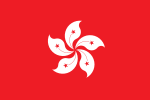 |
since 1997 | Hong Kong flag |
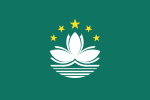 |
since 1999 | Flag of Macau |
Service flags
The flag of the People's Liberation Army and its armed forces all contain the stylized Chinese characters for August 1st (8-1, Chinese 八一 , Pinyin bā yī ), the date of its establishment. The star here stands for their victories in the long struggle to drive foreign powers out of China and to unite the country.
| flag | use |
|---|---|
 |
Flag of the People's Liberation Army , war flag |
 |
Land Forces flag |
 |
Flag of the Air Force |
 |
Naval Forces flag , naval war flag |
See also
Web links
- Flags of the World - China (English)
Individual evidence
- ↑ Mao Zedong: Selected Works, Vol. 4, Peking (publishing house for foreign language literature) 1969, p. 444ff.
- ^ A b Smith / Neubecker: Coats of arms and flags of all nations, Munich 1980, ISBN 3-87045-183-1 .
- ↑ Incorrect China flags in Rio: Under a false flag. tagesschau.de, August 8, 2016, accessed on August 8, 2016 .

